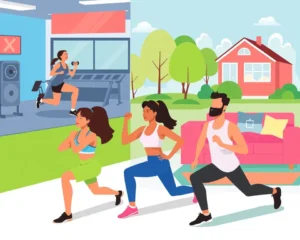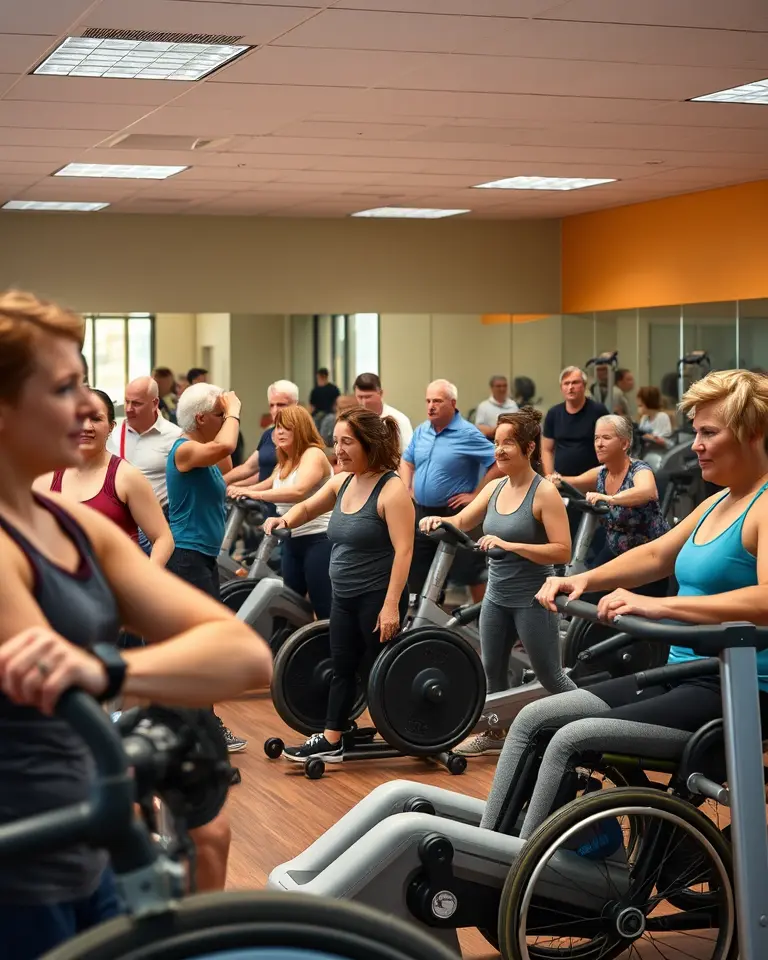In a world increasingly focused on health and wellness, the concept of inclusive fitness is gaining significant momentum. All abilities gyms, also known as adaptive fitness centers, are revolutionizing the way people with disabilities approach exercise. These specialized facilities provide a welcoming and supportive environment where individuals of all abilities can pursue their fitness aspirations. This article explores the importance of these gyms, the benefits they offer, and the steps being taken to make fitness more accessible for everyone.
The Rise of Adaptive Fitness
Traditional gyms often present barriers for individuals with disabilities. Limited accessibility, a lack of specialized equipment, and staff unfamiliar with adaptive training techniques can make these environments intimidating and ineffective. Adaptive fitness aims to break down these barriers, offering a tailored approach to exercise that accommodates various physical, cognitive, and sensory needs. Over the past 15 years, this movement has transformed the wellness landscape for many.
Why Adaptive Fitness Matters
Physical activity is crucial for overall health, offering benefits such as improved mood, increased energy levels, and reduced risks of chronic diseases. However, for people with disabilities, these advantages are not easily accessible due to various challenges. These challenges often lead to sedentary lifestyles, which can worsen health conditions and lead to social isolation. Adaptive fitness addresses these issues by offering a viable and inclusive path to wellness. Whether it’s wheelchair basketball, seated yoga, or weightlifting with assistive devices, adaptive fitness makes exercise feasible and enjoyable for everyone.
Key Components of All Abilities Gyms
All abilities gyms go beyond basic accessibility, providing a comprehensive approach to fitness. Several components make these facilities unique and effective.
Individualized Fitness Plans
One of the core principles of an all abilities gym is the development of personalized fitness plans. These programs are designed to cater to each individual’s unique needs, goals, and limitations. Trainers take into account a range of factors, including the type and severity of the disability, any underlying health conditions, and personal preferences when creating a tailored plan.
Specialized Equipment
Adaptive gyms are equipped with a variety of specialized equipment to accommodate individuals with diverse physical challenges. This equipment may include:
- Wheelchair-accessible machines: These machines allow users to perform both strength training and cardiovascular exercises without having to transfer out of their wheelchairs.
- Recumbent exercise bikes: Ideal for individuals with limited mobility or balance issues, these bikes provide a safe and comfortable full-body workout.
- Hand cycles: These allow individuals who use wheelchairs to engage in cardiovascular exercise.
- Adapted resistance bands: These bands provide a range of resistance levels suitable for varying strength capabilities.
- Stabilizing devices: These are crucial for ensuring the safety of people with mobility challenges.
- Deluxe Resistive Pedal Exercisers: These portable devices can be used to exercise both arms and legs and provide a way to increase aerobic exercise, build fitness, stamina and strength.
Trained Professionals
The staff at an all abilities gym is a key component of its success. These gyms employ adaptive personal trainers who are trained to work with people with disabilities. They are skilled in modifying exercises, providing necessary accommodations, and creating customized fitness programs. Many trainers have specialized certifications, such as the Inclusive Fitness Specialist Certificate from the American College of Sports Medicine (ACSM).
Focus on Functional Fitness
While traditional fitness often emphasizes aesthetic goals, adaptive fitness focuses more on improving daily life functionality and independence. The exercises are designed to help individuals perform everyday tasks more easily, such as improving balance, coordination, and strength for mobility.
The Benefits of All Abilities Gyms
Engaging in adaptive fitness at an all abilities gym provides numerous benefits for individuals with disabilities.
Physical Health Improvements
Regular exercise through an adaptive program improves physical health in several ways:
- Increased Strength and Endurance: Adaptive workouts help build muscle strength and improve endurance, allowing individuals to perform daily activities more efficiently.
- Enhanced Cardiovascular Health: Regular physical activity improves cardiovascular function and reduces the risk of heart disease.
- Improved Flexibility and Balance: Specialized exercises can improve flexibility and balance, reducing the risk of falls and injuries.
- Maintaining Muscle Balance: Adaptive fitness helps maintain muscle balance which is important for overall physical health.
- Motor Skill Development: Adaptive sports and fitness enhance fine and gross motor skills.
Mental and Emotional Well-being
The benefits of all abilities gyms extend beyond physical health:
- Improved Mood and Reduced Stress: Physical activity releases endorphins, which help improve mood and reduce stress.
- Increased Self-Esteem: Achieving fitness goals can boost self-confidence and self-esteem.
- Sense of Accomplishment: Overcoming challenges and achieving milestones provides a sense of accomplishment.
- Reduced Social Isolation: Group fitness classes and social activities foster a sense of community and belonging.
- Positive Body Image: Participating in adaptive fitness helps to promote a more positive body image.
Greater Independence
By focusing on functional fitness, all abilities gyms help individuals gain greater independence in their daily lives. The improved strength, balance, and coordination achieved through adaptive fitness programs enable individuals to perform everyday tasks more easily, increasing their self-reliance.
Overcoming Barriers to Access
Despite the growing awareness of adaptive fitness, significant barriers to access still exist.
Accessibility Concerns
Not all facilities are equipped to accommodate adaptive needs. The lack of accessible entrances, bathrooms, and changing rooms can prevent individuals from using a facility. Furthermore, specialized equipment and trained personnel can be expensive, limiting the reach of these programs to those who can afford them.
Financial Obstacles
The high cost of specialized equipment and trained staff can be a significant barrier. Many adaptive fitness programs are run by non-profit organizations, and funding can be a limiting factor. This financial obstacle restricts access to these facilities for many people who would benefit from them.
Lack of Awareness
Another barrier to access is a lack of awareness. Many individuals with disabilities are not aware that adaptive fitness programs and facilities exist. Increased outreach and education are needed to inform the public about these opportunities.
Transportation Difficulties
Transportation to and from gyms can be a challenge for some people with disabilities, especially if they do not have reliable access to ride-sharing or public transport.
Creating Truly Inclusive Fitness Centers
To make adaptive fitness universally accessible, several steps need to be taken:
Investing in Accessibility
Both public and private organizations need to invest in affordable programs and facilities. This includes ensuring that buildings are physically accessible, equipped with specialized equipment, and staffed by trained professionals.
Training and Certification
Providing more opportunities for fitness professionals to get certified in adaptive fitness is also essential. The ACSM’s Inclusive Fitness Specialist Certificate is a good example of a program that is providing fitness professionals with the necessary training and skills.
Promoting Universal Design
Adopting the principles of universal design in the fitness industry is vital for achieving equitable access. Universal design ensures that facilities are accessible to everyone, regardless of age, ability or any other demographic.
Engaging the Disability Community
It is important to partner with the disability community, assessing facilities and making needed changes based on their experiences. Regular assessment is needed to ensure that fitness centers continue to meet the changing needs of their members.
Public Awareness Campaigns
Public awareness campaigns are needed to educate individuals with disabilities about the benefits of adaptive fitness and the options available to them. These campaigns could highlight the success stories of people who have been transformed by these facilities.
Success Stories of Adaptive Fitness
The power of adaptive fitness is best demonstrated through the success stories of those who have benefited from it:
- Victor Assaf, a CrossFit athlete who overcame a motorcycle accident which left him unable to use his right arm, has become a top-ranked competitor in adaptive CrossFit.
- Greg, a wounded veteran, was able to lose 360 pounds and recover from the effects of medication and surgery through participation in adaptive sports.
- Maddy, a young woman with cerebral palsy, has gained strength and become more active through participation in adapted physical education programs.
These stories highlight that with the right tools, training and support, anyone can achieve their fitness goals.
The Future of All Abilities Gyms
All abilities gyms represent a significant step forward in making fitness accessible to everyone. These inclusive facilities provide a supportive environment where people with disabilities can pursue their health and wellness goals. As the understanding of adaptive fitness expands, the importance of creating more inclusive gyms that cater to a variety of abilities continues to grow. The future of fitness will be one that emphasizes inclusivity, accessibility and personalization, ensuring that everyone has the chance to lead a healthier and more fulfilling life.







